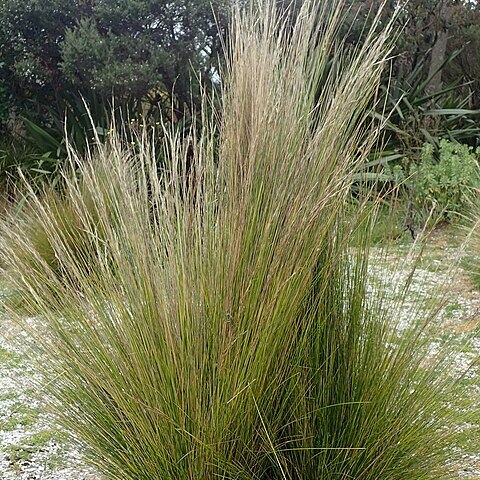Tall, caespitose, stiff, erect perennial with swollen bases occasionally with elongating basal internodes and branching at nodes; branching intravaginal; cataphylls small. Leaf-sheath to 25 cm, smooth, very short hairs often between ridges. Ligule 3-7 mm, decurrent, symmetrical or asymmetrical, nerved, subacute. Leaf-blade to 60 cm × 0.7 mm diam., rigid, folded but appearing terete, abaxially glabrous, sharply acicular, adaxially with abundant short white hairs and some prickle-teeth towards base. Culm to 1 m, internodes glabrous, nodes concealed. Panicle to 20 cm, narrow; branches ascending; rachis, branches and pedicels glabrous. Glumes ± equal, to 20 mm, 3-nerved, produced into awn-like processes ± 1 mm, or acuminate, > awn column. Lemma 8-10 mm long, fuscous, hairs white or brown (± 2 mm), lobes hairy, 1-2 mm; coma to 3 mm; awn to 35 mm, short stiff hairy, 1-geniculate, column strongly twisted to 10 mm, arista to 25 mm. Palea with abundant long internerve hairs, few elsewhere, entire or shallowly lobed, apex shortly ciliate. Callus to 1.5 mm, hairs to 1.5 mm. Lodicules 3, usually 1-2-nerved, acute, ligulate, to 2.5 mm, often 1-or 2-fid, adhering to caryopsis. Anthers apically and basally caudate, to 7.0 mm. Plate 5C.
More
Plants to c. 1.2 m tall, with a basal leaf-tuft. Culms erect, 0.6–1 mm wide, glabrous; nodes c. 3, not exserted, glabrous. Leaves: sheath ±inflated at base, weakly ribbed, glabrous to shortly pubescent between nerves, glabrous on margins; ligule 4–9 mm long, obtuse, papery, glabrous; blade subterete, permanently folded, to c. 70 cm long, 0.6–1.1 mm wide, with a needle-like point, slightly ribbed and with minute hairs on adaxial surface, glabrous or scabrous on margins. Inflorescence 10–25 cm long; spikelets laterally compressed. Glumes equal to subequal, 12–20 mm long, acute. Callus 1–2.5 mm long, with dense white to light brown hairs. Lemma cylindrical, 8–13 mm long, very faintly granular, pilose; coma obscure; lobes 0.5–3 mm long; awn 20–40 mm long, scabrous, with column 10–15 mm long. Palea acute. Lodicules 3.

